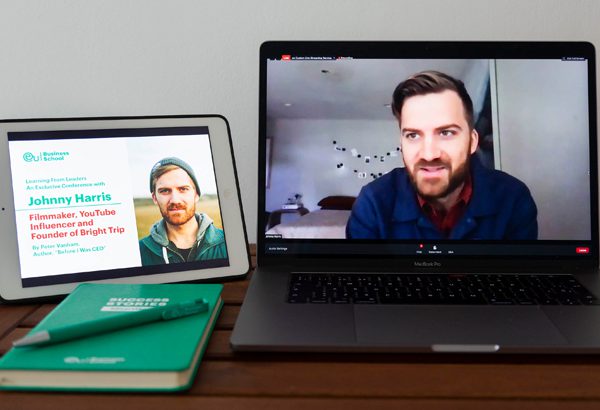Why Customer Experience Is Crucial With Marta Pique
Marta Pique drew upon her 20 years of varied business experience when she presented to EU Business School students. Her focus was the importance of customer experience. Marta began her career by working in the field of marketing, and she spent four years with multinational food corporation, Danone. She then moved to work in Renit Benckiser, her first experience working in the pharmaceutical industry. Marta spent 11 years in total working in the marketing and trade department. This led to another pharmaceutical position with Alliance Healthcare. In 2019, her career path took a new direction as she moved into customer experience for Boehringer Ingelheim.
Five Career Lessons
Marta shared five lessons from her career with EU Business School students:
1. Keep trying! Better results come from 10 attempts and five mistakes than two attempts and one mistake.
2. Be flexible. When you work in business you work in an ever-changing environment; you have to manage cycles of expansion and recession alike.
3. It’s more important to do things in a timely manner than it is to do them perfectly. An obsession with perfection will slow you down and make you ineffective.
4. It’s important to build resilience, as that is what gives the strength to manage the inevitable moments of adversity you will face.
5. Feel free to restart your professional life whenever you want, but always seek good advice first.
Changes in Consumer Habits
Marta highlighted the ways in which customer experience has significantly changed in recent times.
She explained that shopping used to be considered a sociable activity, and people tended to go to the mall to enjoy a customer experience. Online transactions only represented 3% of all online transactions 10 years ago; however, now they represent 20%. The make-up of high streets and cities has changed as a result of this significant increase.
There has been a general move away from a model where customers could be depended on to buy from the only store of its kind in town to a situation where customers enjoy unlimited choice without even leaving the house.
The smartphone has also had a huge impact, as Marta recognized. Customers are regularly exposed to items they may not have considered buying before, and brands position themselves on social media in order to attract customers. This means even companies with a low advertising budget can enjoy heightened visibility.
The algorithm on social media platforms tailors advertising to the specific interests of users, with often spookily accurate results. Women and young people are now especially willing to buy online, which has caused a boom in e-commerce. E-commerce is definitely here to stay.
What is Customer Experience?
Customer experience is the customer’s perception of how a company treats them. These experiences build memories and feelings associated with the company, and positive experiences drive customer loyalty and repeat business. Marta explained this loyalty as a kind of love. The aim of a business should always be to develop a long-term relationship with their customer.
Whether the interaction is online, over the phone, or in-person, customers should feel that they experience your company in a consistent way for them to develop a strong relationship. Even when customers love a company, one in three customers have shared that they’d take their custom elsewhere after just one negative interaction. Every interaction counts when it comes to customer experience.
What is the Customer Journey?
The customer journey is the complete experience that a customer has with a company across various touchpoints. This goes from the earliest interaction, when the customer becomes aware of your company, through to the hopeful outcome of advocacy, when a customer recommends your company to other people.
Between awareness and advocacy are consideration, purchase, and retention. A negative interaction could interfere with retention, preventing a customer from reaching the point of advocacy. Customers have also been shown to share negative experiences more widely than positive ones.
How Can We Understand the Customer?
To understand the customer, Marta recommended collecting data across a range of media. These included purchase data, i.e. seeing what customers buy and how often, and social data; for example, what customers say about your company on social media platforms.
Beyond simply analyzing this data, Marta emphasized the importance of acting on it. She mentioned, for example, the impact of negative reviews on a company. Poor customer experiences must be met with a positive response to prevent long-term or widespread reputational damage.
Why is Customer Experience So Crucial?
Surveys have shown that customer experience is considered crucial by companies, beating both product and pricing as their top priority for the next five years. This makes sense when you realize that investing in customer experience has the power to double revenue in 36 months.
Marta proved the importance of customer experience by reminding EU Business School students that the CEOs of both Apple and Amazon commit regular time to responding to customer complaints. This shows that they understand customer experience to be a top priority for their company’s success as a whole.
The fact is that customers highly value customer experience, and they’re willing to spend more to guarantee an exceptional one. When it comes to prioritizing one product or service over another, the level of customer experience that they anticipate can be a deciding factor.
The Starbucks Example
Marta used the example of Starbucks to show how a heightened customer experience could drive profits for a company. Although far cheaper coffees are available, Starbucks retains popularity because it offers a singular experience.
Customers can expect consistency from one country to another in terms of products and excellent service standards. Individual touches like writing customer names on mugs adds novelty and makes the Starbucks experience more memorable for customers. This is why so many people are willing to pay significantly more for a coffee there.
Predicted Changes for the 2020s
Marta predicted three trends for the future of customer experience.
1. Mobile customer experience will be a top priority.
2. Self-service will continue to grow, and companies will use AI to improve customer experience.
3. Customers will expect higher levels of personalization across every company interaction.










